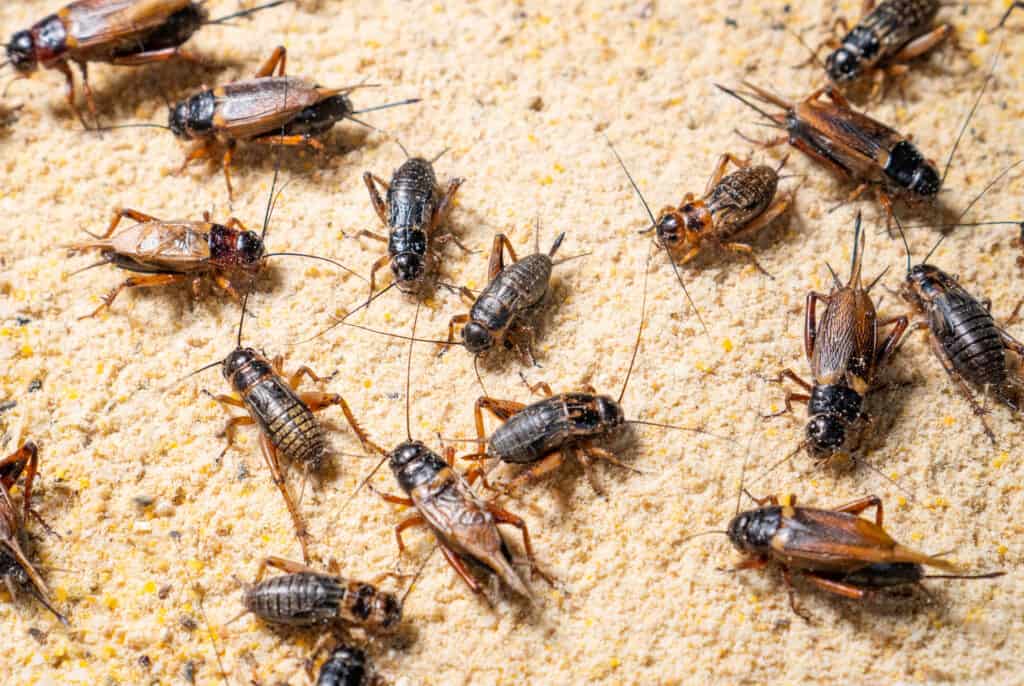The sound of crickets chirping throughout the night is the soundtrack to many people’s summer. With so many of these tiny creatures emerging at once, they’re very hard to ignore! We often talk about how far crickets can hop, their mating strategies, or even their life cycle. However, have you ever wondered about their bathroom habits? If so, we’ve got you covered. Here’s everything you’ve ever wanted to know about cricket poop.
What Does Cricket Poop Look Like?
Unlike the feces of other animal species, cricket poop dries incredibly fast due to its small size. They are small, dark, rounded pellets. Cricket poop is similar in appearance to poppy seeds, and one cricket is capable of producing a large amount. In the wild, it might be difficult to identify cricket droppings in a natural landscape. However, they are much easier to spot in the home.
If you have a cricket infestation, chances are their droppings will be one of the first signs (second only to their chirping). If this is a concern for you, you can also check for cricket eggs. Unlike cricket poop, cricket eggs are light in color and bear a closer resemblance to a grain of rice. Luckily, crickets in the home aren’t as large of a concern as termites, ants, or other pest insects. However, it’s still important to deal with them swiftly after first noticing their presence.
Does Cricket Poop Make Good Fertilizer?

Cricket frass is very affordable.
©Maria Sbytova/Shutterstock.com
Those of you with backyard gardens will be pleased to learn that cricket droppings are a popular and effective source of fertilizer. Recently, it has been found that “frass,” a mixture of cricket feces and exoskeletons, has had positive effects on plant growth. According to a journal authored by Annrose Wanjugu, Peter Bulli, and Darius Andika, “The use of cricket frass improves the soil organic water hence water retention and increases available nitrogen in the soil resulting in improved vegetative growth. Integrated insect farming with livestock production and crop production will create a circular economy that will contribute positively to the fight against food insecurity.” So not only does cricket poop make good fertilizer, but producing it has other benefits as well.
Does Cricket Poop Smell?

The lifespan of a cricket lasts roughly two to three months.
©iStock.com/amnat jomjun
Since cricket poop is very small and dries quickly, it doesn’t usually have a smell. However, in moist locations where there is a high density of droppings, an unmistakable (and unpleasant) odor will begin to form. Warm, high-humidity environments will experience worse smells due to fermentation, whereas dry and cool areas will likely stink less. If you’re having trouble eliminating the smell produced by cricket droppings, try adjusting the conditions in the area with this in mind. Apple cider vinegar can also be useful for masking odor.
Is Cricket Poop Dangerous?

Cricket activity seems to be at its peak during the hottest months.
©iStock.com/Triggermouse
Let’s face it, although cricket droppings are useful in some ways, it’s still poop at the end of the day. Because of this, it’s natural to be concerned about health and safety when around large amounts of it. Crickets aren’t necessarily dangerous insects. They are highly unlikely to bite, and usually only do so out of desperation as a last resort. However, the real danger is related to the diseases they carry. Salmonella and E. coli are two of these diseases, which are very harmful to humans, especially those who are immunocompromised. Although the risk of becoming infected is low, it is always recommended to use proper safety gear when handling cricket droppings. Direct contact with skin will put individuals at a higher risk of infection and disease, so avoid doing so at all costs.
Where Do Crickets Poop?

Those trying to reduce the presence of crickets in their garden can plant peppermint and lavender as these are natural deterrents.
©Petr Ganaj/Shutterstock.com
Since crickets live in the wild, they go to the bathroom wherever they deem fit. This means that cricket poop is everywhere and anywhere. If you’re unlucky enough, it may even be lurking in your own home. In general, cricket droppings will be the densest around their food sources. Outdoors, this could be in forested or grassy areas, in leaf litter, underground, or in piles of garbage. Indoors, crickets are more limited in their hiding spots. As a rule of thumb, crickets like to avoid interaction with humans as much as possible. Because of this, they prefer warm areas with very low foot traffic. This is where you’ll be most likely to spot piles of cricket feces if you’re experiencing an infestation
Final Thoughts
Crickets are omnivorous, and their diet consists of both plant matter and other insects. Aphids, leaves, larvae, seeds, eggs, fruit, and fungi are all on the menu. Their feces are made up of the bits and pieces that they weren’t able to use up. In essence, cricket poop is relatively useful but should be handled with care. It’s useful for plant farming and gardening, and many discoveries are made with each passing year. However, it’s important to remember to never touch cricket feces barehanded, and address any indoor infestations as quickly as possible to avoid disease.
The photo featured at the top of this post is © Petr Ganaj/Shutterstock.com
Thank you for reading! Have some feedback for us? Contact the AZ Animals editorial team.







